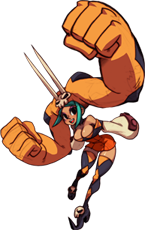[Damage x N] – The Problem With Loops
April 12th, 2011
Written By: Peter Bartholow
A loop, as defined in fighting games, is a repeatable series of hits in which the last hit of the series leads back into the first hit. Loops are everywhere in competitive play, and it’s easy to see why: a practical loop is often the easiest, most consistent way to squeeze the most damage out of a single hit – your definition of practical may vary, of course.
A loop which could be repeated forever if the opponent had unlimited health is called an “infinite combo,” and one touch from a character with a practical infinite combo is usually deadly. Loops allow characters to easily reach, if not flat-out exceed, their maximum developer-intended damage potential off one hit, which in many cases upsets the balance of the game.
For instance, fast or tricky characters are generally designed to be able to do less damage off a successful hit than slow, powerful characters, which is the validation for making the powerful character slower in the first place. Naturally, the faster character tends to be able to land hits more easily, so each hit should do less damage. Now if players discover a loop or infinite combo for a fast character, suddenly their damage potential is at least as good as a slower, originally-more-powerful character’s, which completely negates the intended design disadvantage. This is why players are always looking for loops, even those limited by other aspects of the game rules.
Much like spaghetti strings in tennis, easy loops are commonly regarded as unrelated to the nebulous concept of “player skill.” “Skill” is more commonly attributed to the application of strategy, setups, footsies, yomi, abare, okizeme and other fancy Japanese names for interactions which involve a player out-performing his or her opponent in a situation, rather than simply executing a series of actions that guarantee a win while the opponent is helpless. Just as professional sports ban those equipment advances viewed as granting an unfair competitive advantage (and thus go against the “spirit” of the sport), some fighting game communities ban loops which affect the balance of the game too much. Quite apart from this, I personally find loops fairly boring to watch, and even more boring to get hit by while playing.
Game developers have tried many solutions to prevent characters from having loops useful enough to affect game balance: hitstun scaling or gravity scaling over the course of a combo, same-move prorating, a limited number of “combo points,” bursts, and MAXIMUM DAMAGE are just a few examples. None of them worked. Why not? Because all of these approaches are general and game-wide, so to the game all combos are the same. Thus the system has to be lenient enough to allow “regular” combos but still effective enough to stop loops and infinites, without being able to tell the difference!
Developers test the games intensively and fix problems which arise during development that the system doesn’t properly detect by tweaking the characters and sometimes the system itself. However, testing is never able to find 100% of the problems in any game: invariably, when the game is released, loops are found which occupy the grey area that the developers decided was acceptable for a combo to continue and the whole system breaks down. This leads to a reduction in player incentive to find new and interesting combos – since there is always a “best” combo off any given hit before the game automatically stops you, it actively rewards the discovery of short, repeatable loops! Since loops lead to easy damage and are not stopped immediately they are still a player’s best available option in most situations. Thus, the results are actually contrary to the purpose of the system. For most of the history of fighting games such problems were only addressed in the game’s sequel, and as a result players have grown accustomed to dealing with them during play. The discovery of abusable loops has become an accepted part of a fighting game’s evolution, but is that truly necessary?
Skullgirls takes a fundamentally different approach to this issue: of course we test the game rigorously, but as developers we are also sane enough to admit that we will not be able to find all of the problems. After all, players are incredibly creative and innovative, and they are also highly motivated to find the most exploitable tactics possible. A game can only truly be tested once players get ahold of it, learn how it works, and the playstyle has time to evolve. With that in mind, the Skullgirls engine actually adapts per combo to detect loops and allow the opponent an opportunity to escape. That means there is no grey area, and when a loop is discovered that we didn’t remove it won’t be a game-breaking advantage. The system can even be “nicer” early on in a combo, which lets players re-use moves and exercise their creativity while still guaranteeing no practical infinite combos exist. In effect, this system rewards the discovery of non-looping combos rather than rewarding the discovery of the easiest possible loop.
Having this loop-detection system in place allows Skullgirls to make one other very important change in fighting game design: it allows the developers to not limit the characters in any other way! We don’t have to change the way hits work, remove dash cancels or special cancels on certain moves, introduce extra artificial combo-ending knockdown or pushback, cap the damage, force moves that usually connect to not combo together, or otherwise put a straitjacket on player freedom in order to avoid potentially destructive infinites. Anything you can think of, you can do – only this time, it’s not all about simply landing that first hit.







